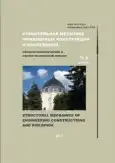ПАРАМЕТРЫ ПОРОДНЫХ КОНСТРУКЦИЙ ПРИ ПОДЗЕМНОЙ ДОБЫЧЕ РУД
- Авторы: РАЗОРЕНОВ Ю.И.1, ДЗЕРАНОВ Б.В.1
-
Учреждения:
- Северо-Кавказский горно-металлургический институт (СКГТУ)
- Выпуск: № 6 (2017)
- Страницы: 55-67
- Раздел: Статьи
- URL: https://journal-vniispk.ru/1815-5235/article/view/346371
- DOI: https://doi.org/10.22363/1815-5235-2017-6-55-67
- ID: 346371
Цитировать
Полный текст
Аннотация
В работе обозначена концепция сохранения земной поверхности от разрушения, реализуется путем регулирования напряжений согласованием процессов выемки руды во времени и пространстве по критерию минимизации напряжений. Обоснование технологических решений, обеспечивающих сохранность массива и земной поверхности над ним за счет феномена остаточной прочности нарушенных пород, является целю статьи. Цель достигается в ходе анализа практики горных работ, установленных закономерностей поведения массивов с дискретным гравитационно тектонически- структурным полем напряжений и методов обеспечением их устойчивости путем создания условий для заклинивания пород в пределах свода естественного равновесия. Показано, что геомеханическая сбалансированность дискретных породных сред обеспечивается за счет остаточной несущей способности природно и технологически разрушенных пород. Предложено решение задачи профилактики критических напряжений и соответствующих им деформаций разделением шахтного поля на участки с плоской кровлей, в пределах которых могут быть применены минимизированные по затратам технологии. Рекомендовано дополнить критерий оптимальности погашения величиной компенсации наносимого ущерба окружающей среде. Дана типизация выработок по устойчивости и нарушенности массивов. Сформулировано условие прочности массива на различных стадиях существования условие геомеханической сбалансированности геомеханической системы. По устойчивости в зависимости от размеров структурных блоков пород в кровле выработки могут быть типизированы. Предложена новая классификация технологий погашения пустот с учетом феномена заклинивания породных блоков. За счет остаточной несущей способности природно и технологически разрушенных пород при подземной разработке месторождений возникают породные конструкции, свойства которых корректируются разделением шахтного поля на геомеханически сбалансированные участки с плоской кровлей
Ключевые слова
Об авторах
ЮРИЙ ИВАНОВИЧ РАЗОРЕНОВ
Северо-Кавказский горно-металлургический институт (СКГТУ)
Автор, ответственный за переписку.
Email: info@skgmi-gtu.ru
доктор технических наук, профессор, ректор, Северо-Кавказский горно-металлургический институт (СКГТУ). Научные интересы: разработка месторождений полезных ископаемых, экономико-математические модели, оценка эффективности, проектирование, добыча, способы разработки
Россия, 362021, Россия, г. Владикавказ, ул. Николаева, 44БОРИС ВИТАЛИЕВИЧ ДЗЕРАНОВ
Северо-Кавказский горно-металлургический институт (СКГТУ)
Email: dzboris@gmail.com
кандидат геолого-минералогических наук, ассистент кафедры «Прикладная геология», Северо-Кавказский горно-металлургический институт (СКГТУ). Научные интересы: геотектоника, оценка сейсмической опасности, детальное сейсмическое районирование
Владикавказ, 362021, Россия, г. Владикавказ, ул. Николаева, 44Список литературы
- Shestakov, V.A., Razorenov, Yu.I., Gabaraev, O.Z. (2001). Upravlenie kachestvom produkcii na gornyh predpriyatiyah [Management of the Quality of Products at Mining Enterprises]. Novocherkassk. 262 p. (In Russ.)
- Shestakov, V.A., Belodedov, A.A., Shalyapin, V.N., Tverdohlebov, V.D., Razorenov, Yu.I. (2004). Sposob razrabotki krutopadayushchih rudnyh zalezhej maloj i srednej moshchnosti sistemoj podehta-zhnogo obrusheniya s gibkimi razdelyayushchimi perekrytiyami [Method for the Development of Steeply Falling Ore Deposits of Low and Medium Power By a Sub-Floor Collapse System With Flexible Sep-aration Overlaps]. Patent na izobretenie RUS 2301334 28.12.2004.
- Golik, V.I. (2014). Prirodoohrannye tekhnologii razrabotki rudnyh mestorozhdenij [Environ-mental Technologies For the Development of Ore Deposits]. Moskva, INFRA. 192 p. (In Russ.)
- Haifeng Wang, Yaqun He, Chenlong Duan, Yuemin Zhao, Youjun Tao, Cuiling Ye (2012). De-velopment of Mineral Processing Engineering Education in China University of Mining and Technology. Advances in Computer Science and Engineering. AISC 141. Springer-Verlag, Berlin Heidelberg. P. 77—83.
- Vorob'ev, A.E., Razorenov, Yu.I., Ignatov, V.N., Dzhimieva, R.B. (2008). Innovacionnye ge-otekhnologii razrabotki mestorozhdenij goryuchego slanca i vysokovyazkoj nefti [Innovative Geotech-nologies For the Development of Oil Shale and High-Viscosity Oil Fields]. 214 p. (In Russ.)
- Razorenov, Yu.I., Golik, V.I., Kulikov, M.M. (2010). Ekonomika i menedzhment gornoj promysh-lennosti [Economy and Management of Mining Industry]. Yuzhno-Rossijskij gos. tekhnicheskij un-t (Novocherkasskij politekhnicheskij in-t). Novocherkassk. 251 p. (In Russ.)
- Vagin, V.S., Golik, V.I. (2005). Problemy ispol'zovaniya prirodnyh resursov yuzhnogo feder-al'nogo okruga [Problems in the Use of Natural Resources of the Southern Federal District]. Vladikav-kaz. 192 p. (In Russ.)
- Kaplunov, D.R., Ryl'nikova, M.V. (2008). Razvitie teorii proektirovaniya i realizaciya idej kom-pleksnogo osvoeniya nedr [Development of the Theory of Design and Implementation of Ideas for the Integrated Development of Mineral Resources]. Gorniy Informtzionno-Analitcheskiy Bulleten. No 4. P. 20—41. (In Russ.)
- Golik, V.I. (2014). Special'nye sposoby razrabotki mestorozhdenij [Special Methods for Devel-opment of Mineral Deposits]. Moscow, 132 p. (In Russ.)
- Lyashenko, V.I. (2015). Scientific and Technical Prerequisites for Improving Environmental Safety in the Mining Region. OAO «Chermetinformaciya». Chernaya metallurgiya, No 1. P. 21—30. (In Russ.)
- Vetrov, S.V. (1975). Dopustimye razmery obnazhenij gornyh porod pri podzemnoj razrabotke rud [Allowable Sizes of Outcrops of Rocks in Underground Mining of Ores]. Moscow: Nauka. (In Russ.)
- Pagiev, K.H., Golik, V.I., Gabaraev, O.Z. (1998). Naukoemkie tekhnologii dobychi i pererabotki rud [High-tech technologies for production and processing of ores]. Vladikavkaz: Severo-Kavkazskij gorno-metallurgicheskij institut (Gosudarstvennyj tekhnologicheskij universitet). 571 p. (In Russ.)
- Golik, V.I., Poluhin, O.N., Petin, A.N., Komashchenko, V.I. (2013). Ecological problems of de-velopment of ore deposits of KMA. Gornyj Zhurnal. No 4. P. 91—94. (In Russ.)
- Parker, H.M. (2012). Reconciliation principles for the mining industry. Mining Techn., Vol. 121(3). P. 160—176.
- Lyashenko, V.I., Golik,V.I. (2004). Scientific Bases of Geomechanical Monitoring of the State of the Rock Mass in Underground Deposits of Complex Structure. Cvetnaya metallurgiya, No 10. P. 2. (In Russ.)
- Ismailov, T.T., Golik,V.I., Dol'nikov, E.B. (2006). Special'nye sposoby razrabotki mestorozh-denij poleznyh iskopaemyh [Special Methods of Field Development]. Moscow, Ser. Vysshee gornoe obrazovanie, 331 p. (In Russ.)
- Masloboev, V.A., Seleznev S.G., Makarov D.V., Svetlov A.V. (2014). Assessment of Environ-mental Hazard from Storage of Production and Processing Wastes of Copper-Nickel Ores. Fiziko-tekhnicheskie problemy razrabotki poleznyh iskopaemyh. No 4. P. 138—153. (In Russ.)
- Komashchenko, V.I., Vasil'ev, P.V., Maslennikov, S.A. (2016). The Reliable Raw Material Base to the Technology of Underground Mining of KMA Deposits. Izvestiya Tul'skogo gosudarstvennogo universiteta. Nauki o Zemle. No 2. P. 101—114. (In Russ.)
- Golik, V.I., Khasheva, Z.M., Shulgatyi, L.P. (2015). Economical efficiency of utilization of allied mining enterprises waste. The Social Sciences (Pakistan), Vol. 10. No 6. P. 750—754.
- Golik, V., Komaschenko, V., Morkun, V., Khasheva, Z. (2015). The effectiveness of combining the stages of ore fields development. Metallurgical and Mining Industry, Vol. 7. No 5. P. 401—405.
Дополнительные файлы









